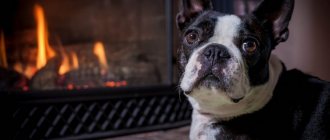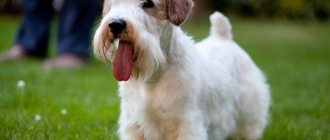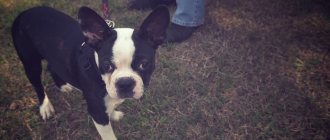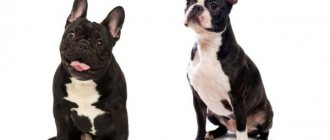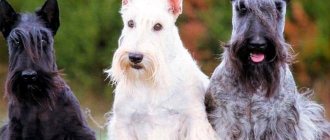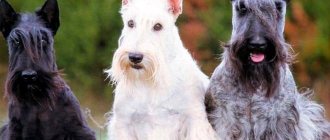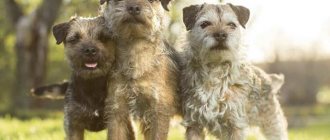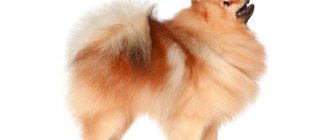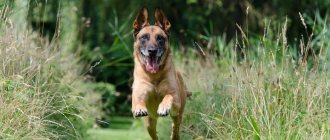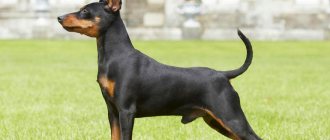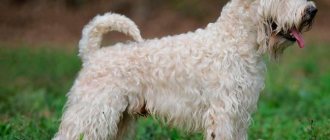Description of the Boston Terrier breed
Popularity 243rd place among 263 dog breeds
Lifespan:
11-15 years
Height:
23-38 cm
Country of origin:
USA
Average price:
40-50 thousand rubles
Weight:
3-11 kg
Latest articles Cat health
Rabies vaccination for cats: choice of vaccine, necessity, schedule 01/22/2022 15 0 0
Selection and adaptation
TOP 20 best cat breeds for families with children 01/22/2022 27 0 0
Psychology
The Boston Terrier has a “golden character”:
- affectionate;
- loving;
- distinguished by intelligence and good manners;
- easy to learn (only without raising their voice, they don’t like it at all);
- characterized by high sensitivity;
- loyal in everything (always protects his masters);
- doesn't fight;
- makes excellent friends with people and other dogs;
- easygoing (therefore it is convenient to keep them at home).
If you give a Boston Terrier enough attention, you will see his remarkable character traits. in this it is not inferior to the Cavalier King Charles Spaniel and the Papillon breed .
Such a dog is perfect for someone who will happily give his tenderness and love to this animal.
The Boston Terrier is perhaps the most positive dog
Key facts
Boston Terriers are friendly, active, small brachycephalic dogs. The description of the Boston Terrier breed is very reminiscent of the French bulldog, but only verbally - visually these dogs are easy to distinguish.
Representatives of the breed are delicate and courteous, and their coloring resembles a tuxedo, which is why they are nicknamed “American gentlemen.”
These dogs do not tolerate heat and cold well. In low temperatures they must be protected from hypothermia, and in the sun - from overheating. Dog clothes cope with this task.
Bostons have all the characteristics of brachycephals (snorting, snoring, a tendency to catch colds), except for one thing - their muzzle is dry, and they do not slobber all around. Many breeders note this as a definite plus.
The Boston Terrier is not a working breed, and if you want to develop some service qualities in it, then training is necessary for this. They are best equipped to protect their homes due to their strong territorial sense of ownership.
The characteristics of the Boston Terrier breed emphasize that the dogs are easy to maintain. They live in peace with other family members, including tailed and winged ones. Due to their docile nature, Boston dogs are great for families with children, retirees and inexperienced dog breeders.
Boston Terriers are not talkative, but they do make funny sounds like snoring or snorting all the time. People with light sleep will have a hard time with brachycephalus. Terriers love to put their paws on others as a sign of their affection - if you don’t like this, you need to pay attention to this moment in raising a puppy.
The Boston muzzle is extremely expressive. When a pet misbehaves, it is literally written on his face. The offended Boston makes such a sad face that all that remains is to start feeling sorry for him and treat him with treats.
You will have to carefully monitor your dog's health. Due to the characteristics of breeding, the breed has acquired a tendency to certain diseases that can be noticed and treated in time. At the same time, the life expectancy of the Boston Terrier is long, and if you take care of its health, it will live up to 15 years.
Walking, physical activity and rules of safe behavior on the street
Boston Terriers love active games, they happily run, jump, and chase their brothers. Lying at home on a soft bedding and slowly walking on a leash behind the owner is boring and not interesting for them. They require active walking for an hour twice a day.
Important! On the street, the dog should not be left to its own devices. He may run after another dog while playing and get lost or get hit by a car. Other dogs may bite him.
In hot weather, it is advisable to go for a walk early in the morning, while there are no scorching rays of the sun, and in the evening, when the sun sets and coolness sets in. On frosty days, the pet wears insulated overalls and boots.
History of the origin of the Boston Terrier
The Boston Terrier is a completely man-made dog breed. The first representative was born in 1870 from the mating of an English bulldog and a now defunct English terrier. The unusual crossbred bribed Bostonian Robert Hooper, who purchased a dog named Judge from his friend William O'Brien.
This male was bred to the white feminine female Jip or Kate by owner Edward Burnett. Jip gave birth to a male, Wells Eph, who was bred to a small female, Tobin Keith. The puppies of this couple are considered the founders of the breed, since it was with them that targeted breeding began.
Initially, breeders of the new breed exhibited their pets under the name “round-headed bullies.” In 1889, the first American Bull Terrier Club was created, but the name was met with dissatisfaction from owners of existing English Bull Terriers who feared breed confusion. As a result, in 1891 the Club was renamed the Boston Terrier Club: the name of the breed was given by the city of origin.
Two years later, in 1893, the AKC recognized the new breed and entered it into the Stud Book, and club members were accepted into the ranks of the organization. The first official Boston is a male named Hector. In 1896, there were enough livestock to hold a special breed exhibition, where the best representative of the breed was the female Topsy.
Due to their size, easy-going nature and cheerful disposition, Boston Terriers have become very popular in the United States. In the first half of the 20th century, more Boston Terrier puppies were registered in America than any other breed. The prevalence of the breed subsided slightly only in the second half of the 20th century due to the Great Depression.
In Russia, the Boston Terrier was officially recognized by the RKF in 2002.
Interesting fact: in the USA, the Boston Terrier is the official symbol of the state of Massachusetts.
Let's sum it up
The Boston Terrier is a bundle of energy. He lifts the mood with just his appearance. His large, expressive eyes will not leave anyone indifferent. For the positive emotions that pets give to their owners, they forgive them any pranks.
When getting such a pet, the owner must take into account that the Boston Terrier requires constant attention. Close communication with humans is simply necessary for these animals. To prevent your dog from causing trouble, you need to regularly exercise and train it. Bostons are true gentlemen, aristocratic manners are in their blood. These are extremely intelligent animals. But, like children, Boston Terrier puppies need supervision and education.
Video
Similar dog breeds
Pug
English bulldog
French Bulldog
Border Terrier
Boston Terrier appearance
The Boston Terrier inherited the brachycephalic face and set of the front paws from the bulldog. The body is devoid of the dampness and stockiness of a bulldog - it is a fit dog with good muscles.
General impression
In the photo of Boston Terriers, it is noticeable that the males are larger and rougher than the females, which look very elegant. Due to its color resembling a tailcoat, the Boston Terrier is considered an American aristocrat, dandy and gentleman. It is often confused with the French Bulldog, but they are two completely different breeds.
Head
The Boston Terrier has a square head, with a short brachycephalic muzzle, a pronounced stop and distinct brow ridges. Under no circumstances should there be folds or “raw” jowls on the head.
The bite of this breed is straight, a slight undershot is possible, the teeth are small, 42 in number. The lower teeth are in a row.
The nose is wide, black, with a distinct stripe in the center. The eyes are almost round, spaced at a sufficient distance. Eye color is only dark. The look is clear and cheerful. The ears are erect, set wide and almost parallel. Can be cropped.
Neck
The neck is of medium length, with a pronounced scruff, without dewlap.
Torso
The body of the dog is square in format, bitches can be slightly elongated in length. The back is straight, ending in a slightly sloping croup. A hunched back is a vice. The chest is of sufficient width and depth and flows smoothly into a taut hemline.
Forelegs
Boston inherited his front paws from a bulldog. Slanted shoulder blades, backward elbows, short strong pasterns and a small, downed paw are characteristic features of the breed.
Hind limbs
Hind legs well muscled and well angulated, parallel and straight when viewed from behind. The paw is arched, with short claws. Dewclaws must be removed.
Tail
The tail is low-slung, can be straight or curled into a corkscrew, thin. The dog carries the tail below the line of the back.
Movements
Movements are free and energetic. A waddling gait is considered a defect.
Wool
The coat is without undercoat, straight and short, the awn lies close to the body. During molting it does not cause excessive trouble.
Color
The Boston Terrier has three standard colors:
- brindle;
- seal (dark brown color, which can be confused with black, but in bright light it casts red);
- black.
There must be white spots on the chest across the entire width, a white blaze on the muzzle between the eyes and on the forehead (preferably even), turning into the outline of the muzzle. Also desirable are white spots on the legs (on the hind legs - no higher than the hocks) and a white collar.
Size
Depending on their weight, Boston Terriers are divided into three categories: mini (up to 6.8 kg), standard (6.8-9 kg) and large (9-11.4 kg).
The height at the withers (aka the height of the Boston Terrier) ranges from 23 to 38 cm. Bostons have well-expressed sexual dimorphism - females are smaller, more graceful, with light bones. The size of male Boston Terriers is significantly larger.
Eye problems
Boston Terriers have bulging eyes that are easily injured. Cataracts, glaucoma, dry eye, corneal ulcers, eyelash disease, and cherry eye are all seen in Boston Terriers.
All of these conditions can be painful or cause blindness. If the owner notices that the dog has red eyes or is squinting, take the pet to the veterinarian as soon as possible.
Boston Terrier personality
The Boston Terrier is a sweet, completely good-natured creature, a favorite of children and adults. He is an excellent companion, completely devoid of anger, aggressiveness and hunting instincts. If you have a Boston, you will never be left without attention, he is friendly and treats everyone around him well.
The character of the Boston Terrier is not dominant; children are the best friends and playmates. Bostons get along well with other animals - both with their fellow tribesmen and with birds, cats, and rodents.
Bostons are calm about the absence of their owners: they will not howl or tear up furniture, but will happily sleep at home on their favorite sofa. If the owner often leaves for a long time, you can make a pet friend, and then they will not be afraid of any loneliness.
You can keep a Boston Terrier either in a small apartment or in a spacious country house, but it must be kept at home. Boston walks quite moderately; in your home you can limit yourself to a walk in the yard for toilet purposes. In winter, these short-haired dogs freeze outside, so it is better to insulate them - dress them in a special overall.
Who is the Boston Terrier suitable for? Because of its peaceful nature, unpretentiousness in everyday life and undemanding nature for long, exhausting walks, the Boston Terrier can be recommended to absolutely everyone.
Pros and cons of the breed
| pros | Minuses |
| Calm and peaceful character. Complete absence of aggression | Trusting strangers |
| Gets along well with children and other pets | May attack street dogs |
| They shed slightly and have almost no odor. | Prone to many diseases |
| Not destroyers. Ideal for apartment living | Cannot be kept in an outdoor enclosure |
The Boston Terrier is an ideal companion, able to adapt to any owner. He will never bite or growl. He will be friendly to everyone. It is easy to find a common language with him. He learns tricks with difficulty, but will learn any command in exchange for a tasty treat.
The Boston Terrier cannot be scolded because it is touchy. But the pet will respond to praise with a sea of love and positivity.
Education and training
Boston Terriers are diligent and obedient students, but they do not grab stars from the sky and do not stand out for their superintelligence. You will need to repeat the exercises several times before your pet begins to confidently understand what is wanted of him. They are quite stubborn, so they can deliberately refuse to follow commands.
Dominance is not one of the Boston's characteristics, so they are fairly easy to train. These dogs need at least basic training from the most necessary commands. The emphasis is on how to stop picking up food from the ground and how to teach not to take anything from the hands of strangers. UGS courses are perfect for this.
If you set a goal, Bostons successfully pass the OKD standards; some representatives of the breed perform well in agility, obedience and freestyle.
Bostons are equal parts eaters and gamers, so rewards in training depend on the preferences of the individual dog. Naturally, only correctly performed exercises should be rewarded. Aggressive methods of education and punishment are categorically discouraged - a stern voice and displeasure from the owner will be more than enough.
Many owners complain about difficulties with the toilet. Even a Boston dog accustomed to walking, who understands where the need should go, cannot and will not tolerate it for long. The solution to the problem can be either frequent walking (3-4 times a day at least) or training the Boston to a litter tray or diaper if you don’t want to wipe the seas all over the house.
Socialization
The Boston Terrier breed is one of the best for families. They adore children, allow them to carry them around and play provocatively with the little ones. But you shouldn’t leave dogs alone with preschoolers, as they can harm the pets.
Conflicts with other pets are excluded. Bostonians accept everyone into their flock - from fellow tribesmen to cats, birds and rodents.
The disadvantages of the breed are excessive gullibility. Dogs love everyone: from the owner to the pizza delivery guy. Therefore, it is necessary to monitor dogs on walks and develop distrust of strangers - Bostonians easily leave with strangers with a gentle voice and a snack in their hand.
Boston Terrier Health and Diseases
Boston can hardly be called a super healthy dog, but he also cannot be classified as a frail breed.
Possible diseases
Genetic diseases that periodically appear in Boston Terriers:
- allergies and atopic dermatitis;
- diseases of the eyes and ears, such as cataracts and complete or partial deafness;
- mast cell tumor, which can be either benign or malignant;
- oncological diseases - melanoma and brain tumor, more common in older dogs;
- consequences of the brachycephalic structure of the skull - hydrocephalus, respiratory problems, pyloric stenosis.
Each disease should be examined by a veterinarian and receive adequate treatment - conservative or surgical.
In addition, Bostons are prone to infections and colds. To avoid dangerous diseases, dogs are vaccinated according to schedule.
The Boston Terrier's nutrition must be monitored and the diet carefully planned so that the dog does not suffer from flatulence and obesity.
Reproductive health
Boston Terrier females mature quite early: the first heat begins at 7-9 months. The duration of estrus is on average 21 days, and the frequency is once every 6-8 months.
To prevent your dog from dirtying the furniture, you can wear special underpants. To avoid unscheduled mating, the dog should be walked on a leash throughout the entire period of estrus and contact with male dogs should be minimized. You should not trust children to walk your pet during heat. If you are not planning on breeding, then a reasonable solution would be to sterilize the dog.
If you want to get offspring, then the first mating is carried out no earlier than the second, or even the third heat - according to age, this is at least 18 months and no later than 4-5 years. Before this, you need to visit at least one exhibition and receive a rating of at least “very good.” choir." Boston Terriers are bred on days 9-14 of estrus: it is at this time that the bitch allows the male to mount.
Pregnancy in females usually lasts 63 days, plus or minus a week. Starting from the second half of pregnancy, the bitch is transferred to 3-4 meals a day and calcium supplements are added. Your veterinarian will advise you on the dosage.
But with childbirth everything is more complicated. It is best if a veterinarian or an experienced breeder is present at the birth. Due to the structure of the skull, bitches giving birth may have breathing problems, and puppies may have very large heads that do not extend into the birth canal. Sometimes Bostonians have to have a caesarean section, especially mini-category bitches.
Usually this breed has 3-5 puppies; there should be as many afterbirths as there are babies. You can let the bitch eat a couple of afterbirths, but no more.
After birth, it is better not to touch the mother and babies for several days, but make sure that all puppies get milk, and weak ones are placed at the breast.
Possible diseases
The breed is distinguished by fairly good health and strong immunity. The main thing is to vaccinate the puppy against various diseases in time, and then the diseases will not be scary for him. However, among the most common diseases of this breed, experts identify the following:
- Cataract.
- Birth injuries associated with hip or knee dislocation.
- Deafness from birth.
- Problems with the stomach, namely its pathological narrowing.
- Cancers of the skin.
Features of feeding and diet
What to feed, how to feed, how many times to feed – these are the questions that most concern the newly-minted owner of a Boston Terrier.
First, you need to choose the type of food - will you feed your dog natural food or industrial food.
Your breeder will give you initial recommendations on feeding your dog, since at two to three months the puppy’s nutrition should be the same as at one month of age from the start of complementary feeding. Over time, it will be possible to switch the animal to the diet that is convenient for you, but you should not do this suddenly - the breed suffers from flatulence.
Industrial feeds are preferred due to their balance and simplicity. There is no need to calculate KBZHU, cook, in addition, it is easier to take dry food or canned food with you on a trip and not think about where you will cook porridge with meat for your pet. The food must be of high quality, premium class or higher.
If you decide to feed your dog natural food, the diet should be based on meat with a small addition of cereals, vegetables and dairy products. About 1-2 times a week you can give your Boston boneless sea fish and raw eggs, especially the yolk.
You cannot feed or treat a Boston Terrier:
- fatty meat, lard, shish kebab;
- various sweets, buns, chocolate and ice cream;
- legumes and potatoes;
- some types of cereals, for example, millet and pearl barley;
- bones;
- river fish;
- whole milk and full-fat cheese.
Since this is a breed with erect ears, in the first months of life you can give the dog cartilage, jellied meat, and vitamin supplements with chondroitin so that the ears rise faster. Do not overfeed your dog - follow portion sizes.
Features of dog care
Keeping a Boston Terrier at home is not difficult, but the animal will definitely require care and attention.
Maintenance and walking
The pet must be kept in a warm room. It is advisable to organize a separate dog area with warm bedding or a house. They walk the dogs at least twice a day, taking into account weather conditions. Extreme heat or cold is contraindicated for Bostonians. During the hot season, it is recommended to take a bottle of water and a bowl for a walk so that, if necessary, you can drink and cool your pet, which is languishing from the stuffiness. Street walks are usually short and moderately active (ball games, light jogging).
Hygienic care for a Boston Terrier puppy is simple, but responsible. The short hair of dogs is periodically combed out with a rubberized mitten, and bathing is done as soon as it becomes heavily soiled. The muzzle requires more frequent cleaning, because... gets dirty from eating and drinking. But the most serious procedure is eye care. They are convex and poorly protected, so they can easily catch an infection. For prevention, each eye should be wiped daily with a separate cotton napkin.
Bostonians need to have their mouth cleaned twice a week. To do this, use dog paste and a special attachment to remove yellow plaque. In addition, every six months your pet needs to carefully clean its ears and trim its claws.
Feeding
The diet of Boston Terriers is not particularly fancy. The pet can be fed raw dietary meat, sea fish fillets, offal, fermented milk, vegetables, quail eggs, buckwheat, and rice. Since the breed is prone to obesity and suffers from flatulence, the Boston Terrier should keep its weight at a normal level: do not overfeed the dog or treat it to unhealthy foods. Prohibited foods include fatty meat, legumes, potatoes, river fish, pearl barley and millet, as well as any sweets.
Taking care of your pet's health
The breed is characterized by good health, but due to physiology, Bostonians are vulnerable to colds and viruses. In addition, it is worth considering the dogs' genetic predisposition to atopy, cataracts, hydrocephalus, deafness, mastocytoma, tumors and breathing problems. Timely vaccination of puppies significantly reduces the risk of getting these diseases. The first vaccinations for dogs are given at the age of 2-2.5 months, and some vaccines (for example, against rabies) are administered only at 6-7 months of the dog’s life.
Related article:
Small dog breeds - top 35 breeds with photos and brief descriptions. It may also be interesting to read a list of the smallest dog breeds with photographs and a brief description of their characteristics.
Care and maintenance
In terms of hygiene, Boston Terriers are unpretentious and inexpensive; they do without haircuts and visits to grooming salons. Periodic brushing with a furminator comb is enough for them to remove dead fur, although during the molting period this can be done a little more often - once every 1-2 days.
Bostons are washed when they get dirty or before shows. In the latter case, there are special shampoos. Paws and tummy can be washed after each walk. The dog's face requires special attention - after eating it is necessary to remove any remaining food.
The eyes are wiped with a napkin every morning, and the ears and claws are treated 1-2 times a month. For claws, it is better to use a regular nail clipper/secateur. If the ears do not stand up on their own, then at 3-4 months they are glued in a standing position. You can leave them like this for up to 5 days. At this time, it is better to try to pat your pet on the head as little as possible.
Once a week, Bostonians brush their teeth with a brush and a special paste, and in between they are allowed to chew on a treat that is good for their teeth.
Boston dogs can only be kept at home. Due to poor thermoregulation, dogs love to sleep in bed, under a soft blanket. Buy your pet a soft, enclosed house if you don't want your dog to take over your bed.
Bostons adapt well to diapers, but, unlike Chihuahuas and toy terriers, they definitely need to be walked. You can start walking after all the basic vaccinations, but before that it is better to take the puppy outside, but not let him down on the ground.
In hot weather, it is better to bring water with you, and in cold weather, wear warm overalls on your Bostonian. You can take a toy with you and spend time actively, if the weather and your pet’s mood permit.
Keeping and caring for a Boston Terrier is not much different from keeping any other small short-haired dog. So there will be no problems with this cute animal.
Hygiene
The terrier's eyes and ears require daily care. The eyes are wiped with a napkin soaked in tea leaves or chamomile decoction. The ears are cleaned of dirt and sulfur secretions with swabs dipped in warm water. A dirty face should be wiped with a napkin after eating.
Claws usually wear down on their own during intense walks. But if this does not happen, they need to be trimmed as they grow, no more than once a month.
On a walk
Tips for choosing a puppy
You should only buy a Boston Terrier puppy in Russia from RKF kennels - the pedigree guarantees the appearance and character of the Boston Terrier, although the price for such puppies is not low.
The puppy must have a set of documents - an RKF puppy card, which after six months will be exchanged for a pedigree, a veterinary passport, a brand on the belly or in the ear. If the parents are champions, you can ask to see their diplomas and certificates. Often good breeders test dogs for hereditary diseases; ask for test results.
Aggressive and pugnacious Bostons are not usually found. Opt for an active, playful, moderately balanced puppy. It is better to buy a baby not on the first visit, but to get to know him at the age of a month and observe him for a while. If the breeder is from out of town, ask for photos and videos of the litter.
Puppies with a humped back are often found. If you are aiming for exhibitions, then it is also better to refuse such a puppy, since the dog may not outgrow this defect.
A conscientious breeder can offer you the best puppy on a co-ownership basis. In this case, you will be the owner, and the breeder is planning matings, looking for a pair, and your puppies will be shown at all exhibitions under the name of the co-owner's kennel. In such cases, a co-ownership agreement is usually drawn up. Most often, he obliges you to pursue the dog’s show career.
Even in the case of a regular sale, a good breeder will give you advice at any time, will be interested in the fate of his puppy, and in case of unforeseen circumstances, he is always ready to take the dog back at any age.
Where to buy a puppy
It is better to buy a puppy from a nursery at the age of 1.5 months. Future owners will be warned about feeding rules and vaccinations. In Moscow there are nurseries: Zolotye Rosy, Boston Style, in St. Petersburg - Bon Fo Show. The price in each case is individual within the range of 800-1000 dollars.
When choosing a baby, you need to pay attention to the healthy characteristics of the breed: the body should be strong, the legs should be straight, the tummy should be medium, the coat should be shiny, the eyes should be clear. Also, a good puppy should be inquisitive and friendly, he will definitely run up and play. If he is afraid of people and sits on the sidelines, it is better not to take him, since you cannot correct his character. Also, you should not buy a teenager or an adult dog - the pet will miss its previous owner.
It is equally important to choose a suitable name for your new pet. So the nicknames Argon, Bill, Edward are suitable for males, and Becky, Vicky, Emma for females.
How much does a Boston Terrier cost?
In our country, Boston Terriers are less common than in the USA, but we also have serious kennels. The price of a Boston Terrier with a pedigree starts from 20,000 rubles. For this price you will get a good pet-class friend without exhibition prospects.
If you see yourself as the owner of a ring star and plan to get offspring, you will have to fork out 50,000-80,000 rubles. In this case, you may have to wait for some time for the right puppy.
The seller can offer a borderline option with permission for breeding, but not making a splash in the ring, for 35,000-40,000 rubles.
Do you like the article? 0
Breeding
In the process of breeding a Boston Terrier, several difficulties may arise:
- The large proportions of the dog's head often entail a caesarean section. This significantly affects the quality of the resulting offspring.
- Males of this breed do not show independent interest in mating. For this reason, artificial insemination is often resorted to.
- The number of puppies in a litter rarely exceeds three to four puppies. In most cases, a healthy bitch will give birth to one or two offspring.
Otherwise, the Boston Terrier is a fairly easy to breed breed and inherits the characteristics of its parents well.
